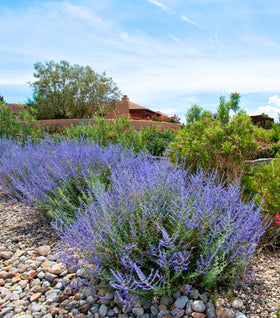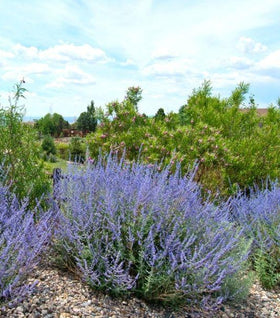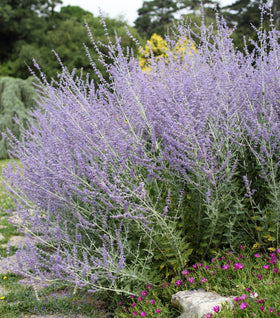Russian Sage for Sale Online
Types of Russian Sage
Perovskia also referred to as Russian sage plants, are hardy, drought-tolerant plants that create lovely shows in any garden. With stems like woody spikes and clouds of flowers that appear in the summer and last through the fall, these plants have quickly gained popularity in the gardening world for their fragrance and unique appearance.
Garden Goods Direct currently offers many cultivars of Russian sage: Perovskia is a semi-woody plant, acting more as a shrub than a perennial, and features small blue flowers on arching stems that grow up to four feet tall. The hazy effect created by the flowers and silvery foliage is almost dreamy, creating a perfect backdrop for other plants in your garden.
Why Plant Perovskia in the garden?
Russian sage is a stunning plant with its dreamy, silvery appearance and spray of aromatic flowers. With these attractive features, perovskia plants create a multi-sensory experience that can improve any garden.
Beyond its aesthetic appeal, the Russian Sage family of plants is beneficial. Whether planting them as a specimen or mass planting, they will last through thick and thin. These plants are not only drought-tolerant, but they’re also heat-tolerant and deer-resistant, making them an excellent choice for a wide variety of gardens throughout the United States.
Tips for Choosing the Right Variety of Russian Sage
The most important part of selecting perovskia for your garden is your climate. While they are very hardy plants, Russian Sage are not meant to live in very cold or hot climates. Perovskia is rated for USDA hardiness zones 5 through 9, making these plants unsuitable for the northernmost and southernmost regions of the continental United States. If you live outside this suitable area, we don’t recommend attempting to grow perovskia sun perennials in your garden.
Beyond this caveat, you can work perovskia into your garden however you’d like, provided they’re given enough sunlight. We recommend planting your perovskia plant as a border plant to contrast pink and yellow perennials in your garden.
How to Care for Perovskia Plants
Understanding perovskia care begins with learning how to plant perovskia. These plants can be placed in areas with full to the partial sun on average, dry to medium, well-drained soils. Avoid soils that retain too much moisture, as this can promote rot. Fertilize the plant to encourage better blooms, and consider adding mulch to help retain moisture.
Once the plant is established, perovskia care is easy. Water your plant as necessary, and cut it back in the late winter to promote new growth. Always check for signs of disease as you go through your daily care routine.



